References:
- Book: Rita Puig-Serra Costa, (2004) “Where Mimosa Bloom”, Éditions du LIC, Optimal Media GmbH
References:
” In an era of face recognition software and data sharing between governments and corporations , the only way to protect your identity, and hence your privacy, may be to destroy all pictures of yourself” – Paul Wombell
Defacing portraits in contemporary photography
The human brain is not too good at remembering faces, where as a computer helped by photography can store all data and make links between different locations and time zones. With a set of numbers a face can be recognized. Facebook is taking this project further, with a face recognition software called DeepFace which is almost as accurate as the human brain when it comes to recognizing faces. In the UK a system run by the government communication head quarters can access photographs on social media sites, emails and texts for facial recognition purposes.
Reasons why you might want to hide your face?
Does face recognition come with power?
If personal photographs on social media and surveillance cameras are accessible not only to your friends and family but also to the government and operations. Can power be defined by how much data can be traced through facial recognition. More recently we have seen an example of this when technology was used to recognize the thousands of refugees travelling from the Middle East to Europe.
In my personal study I have chosen to obscure my mums face with objects and make her identity unknown until the end of the project. I chose to this because I think it links in with her job title, as a domestic I think my mum’s work is in the background and not taken much notice of. I represented this in my photographs by ‘hiding’ her face with an object. When I first started photographing I did this unconsciously, it was only when I looked back at the photographs that I realized and carried on with this idea.




Here is a bit of an experimentation that I did while the Hautlieu School production was going on. I was asked to go down to the drama department and make images throughout the day where cast and crew were performing for their first proper audience of a load of primary school children. I decided to make images from behind the scenes to get more of an inside view of what goes on backstage before and throughout a proper show. I wanted to capture the expressions and emotions of the actors and those watching. I found this to be a great and interesting new experience to be able to go into a more professional environment and for the cast to be comfortable and welcoming to being photographed. The behind the scenes action began at around 10AM and went on until about 2PM. In that time I made over 700 images and have gone through and edited them all and narrowed it down to my favourites in this post. Most of the images that I made throughout the day are from behind the scenes and give a bit more detail into the goings on in a Hautlieu School production. The images are documentary style and are simply behind the scenes of the school production giving the spectator more of an insight into what goes on when the actors aren’t on stage and turned on as well as some images from their performance in front of their first proper audience.
For the second week of my internship I began at Jersey Arhcives in the morning to order my copies of two documents; Francis Le Feuvre’s will & testament, as well as his German Occupation Registration Card. I registered as a Jersey Archive member in which I recieved a started pack and watched a short 5 minute video outlining the process and consideration of using the ‘reading room’.

I then went up to the reading room and ordered the two documents I needed. I found the process to be difficult to follow at first because I had never been exposed to such an environment before. The staff there however were really friendly and hellped me out a lot.
I then reported my findings to Gareth back at the Société Jersiaise and we had a brief chat about my views of this experience and my evaluation of my findings.
I spoke to my Nan about the image in question of Jack, David and Edward Le Feuvre – of whom all emigrated to New Zealand. She stated clearly that this had no connection to possibly my Granddad’s brothers.
On this note, we decided to venture downstairs to the Societere library where I went 2 years prior with my Dad and Uncle to view (a very large!) Le Feuvre family tree. This family tree was created by renowned Jersey-French author George Le Feuvre (1891-1984), known professionally under his pen name ‘George d’la Forge’. D’la Forge was distant relative of the family. My Nan recalls providing hospitality for him on a few occasions he visited the family in Kenya.
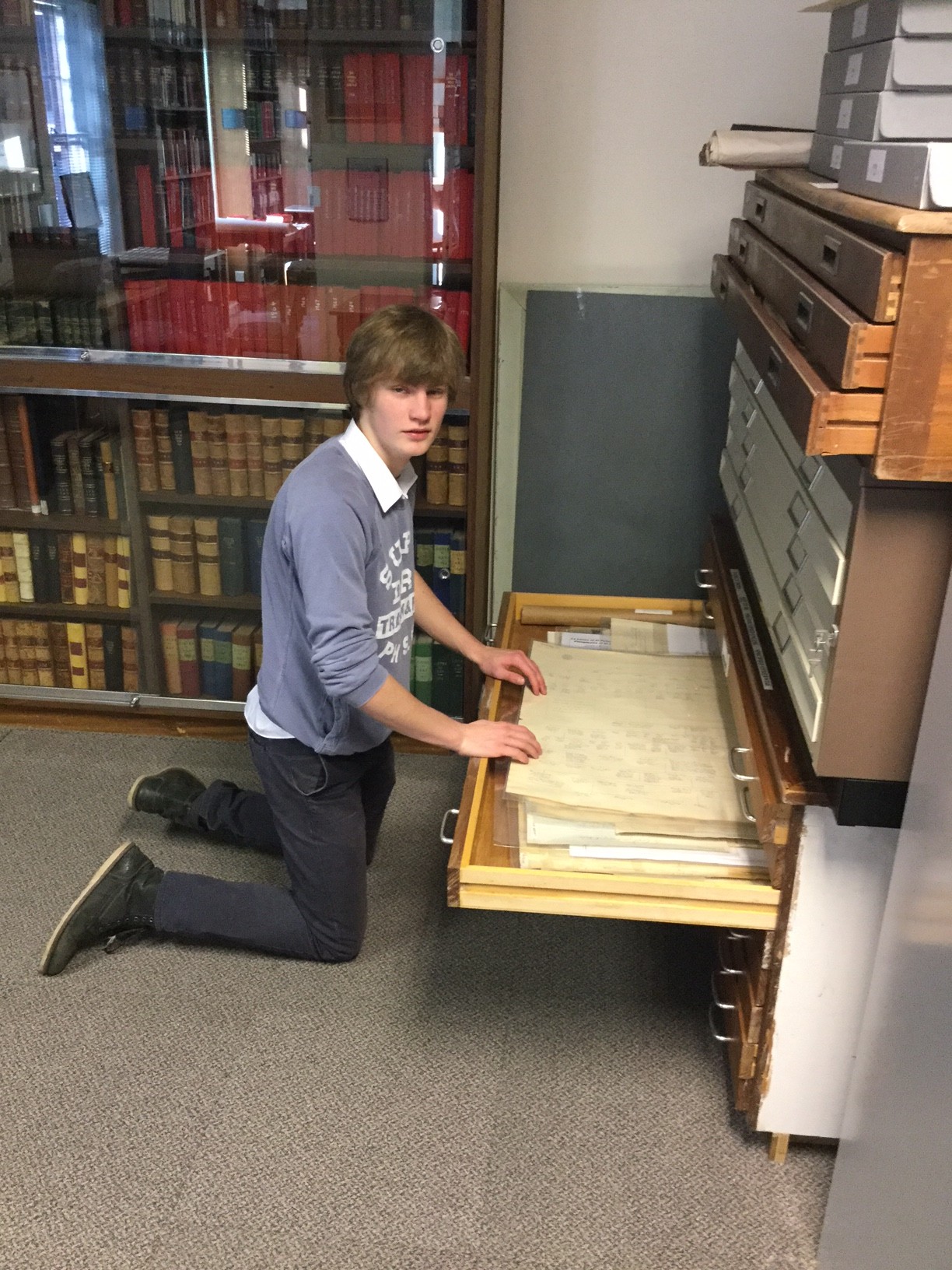
The aim of this visit was to confirm some of the discoveries we have made in the last week. We wanted furthermore to establish the identity of the three Le Feuvre brothers who emigrated to New Zealand.
The tree, consisting of 7 A1 Pages, is an extensive record of the genealogy of the family, dating back to to the mid 16th Century with our oldest ancestor on record, Pierre Le Feuvre. We sourced my Granddad on the tree and his direct line. From this line we established that the three boys in question on the photograph were my Granddad’s first cousins. This may be a possible link to follow in my coursework, however I am unsure whether I have sufficient time to do.
After looking at the family tree, Gareth then got me to complete a task, as a way of furthering my understanding of working life at the Societere. He asked me to fill in a survey looking at the portrait collection of Henry Mullins. I had to source every single photo and then fill on the survey the gender of subject and the backdrop of which their portrait was taking. This proved to be quite a repetitive task and as Gareth jokingly put it “this is the boring side of working at the archives” . Nevertheless it was still fastinating to see the extent of the detail taken at the societere to ensure the photographs and photography collections are as detailed, tracked and monitored as possible. It has made realise quite how obsessive and methodical Gareth is in his approach to running the photo archives.
Afterwards Gareth invited me to read a couple of extracts in a book looking at prominent Jersey people. There we two Le Feuvre’s documented on this book: George Le Feuvre (who wrote the family tree) and Philip Le Feuvre (of which Philip Le Feuvre house is now named after).
Again, I enjoyed my two hours I spent down at the Societere Jersai. I found reviewing my family tree to be very interesting and I forgot just have large it is. My time down archives before the internship to order the registration card and will, was a new and challenging experience. It was interesting to see how the archives centre works, I was surprised quite how simple it was to register to the system and make use of the extremely large quantity of resources on offer.
Today was my first day as an intern at the Société Jersiaise Archives. I am undergoing a 6 week internship (over the course of half term). The idea of the internship is to spend a couple of hours each week down at the archives, in order to aid my studies for my Personal Study project.
I am working with the Société Jersiaise Photographic Archivist Gareth Syvret. He is assisting and guiding me in my studies and providing me with resources the archive has to offer with relevance to Le Feuvre family.
This first session was very much an introduction to the course of the six week internship.
To begin with Gareth showed me a copy of two photographic books. The first book was by French photographer Camille Silvy who took portraits of around 17,000 people in London during the Victorian Period. For comparative purposes Gareth then showed me another collection of photographs, this time by Scottish born Jersey based portrait photographer William Collie. Gareth explained the difference in the two photographers in how they documented their work. While Silvy made his photographs in chronological order with specific dates and a coding system to organise the archival documentation of what was made, Coille was perhaps more artistic in his approach – ordering the pages of his album in terms of status order in which the highest status individuals in Coille’s opinion is at the front of the album, descending down in terms of wealth, power and importance as the book progressive – On reflection whilst it can be argued that Slyvie’s is a collection of images is simply an objective documentation of who lived in London at the time, Coille’s collection on the other hand can be viewed more subjectively from a socio-political stance, his own artistic interpretation being used possibly to challenge and drew questions surrounding the nature of class division within 19th Century Jersey Society.
After this introduction to how the archives operates, we then sat down at the Archive Database in an attempt to uncover archival information about my Grandfather. After a few minutes it was apparent that we couldn’t find much out about my Grandfather. We instead decided to find out information about his father, Francis Vibert Le Feuvre.
A lot more information about this ancestor (my Great -Grandfather) could be sourced. It was revealed that my Grandfather was born in St Peter, Jersey – 1871. In a short space of time we found a stack of archival material relating to my Great Grandfather and other members of his family. In total we found the following;

Quick Biography of Francis V. Le Feuvre
I found this research to be extremely useful and interesting. I have seen first hand the effectiveness of using archival material to get accurate and clear evidence. It is also very interesting to see this evidence directly – documents from the past have a certain haunting presence to them, the sense of re-animating the past into the present. The document which I found particularity interesting were the series of 3 Census’ which Gareth uncovered, ranging from 1881-1911. It was really fascinating to see this Census document because it showed direct evidence of the ages, occupational and status of my ancestors. Which family members (and others) lived in the family home at particular times is a useful indication of how the structure of the family unit operate at different times, and thus how various circumstances effected this.
Mapplethorpe. R (2004), Robert Mapplethorpe and the Classical Tradition, New York: Guggenheim Museum Publications
Davidson, J (2015), ‘Naked Ambition’. The Guardian: 16-17
Lenman. R (2005), The Oxford Companion Photograph, Oxford New York: Oxford University Press
Muybridge. E (1995), The Human Figure in Motion, New York: Dover Publications
Week starting Monday the 18th January
Objectives and Criteria from the syllabus
Be aware of some of the methods employed by critics and historians within the history of art and photography.
Demonstrate a sound understanding of your chosen area of study with appropriate use of critical vocabulary. – use for image analysis
Investigate a wide range of work and sources
Quotation and Harvard System of Referencing
Use quotes to support or disprove your argument
Use quotes to show evidence of reading
Take notes when you’re reading…key words, concepts, passages etc.
Write down page number, author, year, title, publisher, place of publication so you can list source in a bibliography
Use Harvard System of Referencing…see Powerpoint: harvard system of referencing for further details on how to use it.
Here is an overview of an essay structure. See below for a more detailed breakdown on what you could focus on in each paragraph.
Blog: Produce a number of posts that show evidence of the following:
Essay: Complete writing paragraphs 1 , 2 & 3 in your essay
Paragraph 1 Structure (500 words) : Use subheading. This paragraph covers the first thing you said in your introduction that you would address. The first sentence introduces the main idea of the paragraph. Other sentences develop the subject of the paragraph.
Content: you could look at the following…exemplify your hypothesis and introduce your first photographer. Select key works, ideas or concepts and analyse in-depth using specific model of analysis (describe, interpret and evaluate) – refer to your hypothesis. Contextualise…what was going on in the world at the time; artistically, politically, socially, culturally. Other influences…artists, teachers, mentors etc. Personal situations or circumstances…describe key events in the artist’s life that may have influenced the work. Include examples of your own photographs, experiments or early responses and analyse, relate and link to the above. Set the scene for next paragraph.
Include relevant examples, illustrations, details, quotations, and references showing evidence of reading, knowledge and understanding of history, theory and context!
Paragraph 2 Structure (500 words) : Use subheading. In the first sentence or opening sentences, link the paragraph to the previous paragraph, then introduce the main idea of the new paragraph. Other sentences develop the paragraphs subject (use relevant examples, quotations, visuals to illustrate your analysis, thoughts etc)
Content: you could look at the following…Introduce key works, ideas or concepts from your second photographer and analyse in-depth – refer to your hypothesis…Use questions in Pg 1 or add…What information has been selected by the photographer and what do you find interesting in the photograph? What do we know about the photograph’s subject? Does the photograph have an emotional or physical impact? What did the photographer intend? How has the image been used? What are the links or connections to the photographer in Pg 1? Include examples of your own photographs and experiments as your work develop in response to the above and analyse, compare, contrast etc. Set the scene for next paragraph.
Include relevant examples, illustrations, details, quotations, and references showing evidence of reading, knowledge and understanding of history, theory and context!
Paragraph 3 Structure (500 words) : Use subheading. In the first sentence or opening sentences, link the paragraph to the previous paragraph, then introduce the main idea of the new paragraph. Other sentences develop the paragraphs subject (use relevant examples, quotations, visuals to illustrate your analysis, thoughts etc)
Content: you could look at the following…Introduce key works, ideas or concepts from your third photographer and analyse in-depth – refer to your hypothesis…Use questions in pg 1 and pg 2 or add…How does the photograph compare or contrast with others made by the same photographer, or to other images made in the same period or of the same genre by other artists. How does the photograph relate to visual representation in general, and in particularly to the history and theory of photography, arts and culture. What are the links or connections to the photographers in pg 1 and 2? What are the similarities, differences or links and connections? How does this work compare to yours? Include examples of your own photographs and experiments as your work develop in response to the above and analyse, compare, contrast etc. If more paragraphs are required, set the scene for the next paragraph.
Include relevant examples, illustrations, details, quotations, and references showing evidence of reading, knowledge and understanding of history, theory and context!
William Eggleston is an American photographer who is known for working with colour photography. Using his home environment Memphis and Mississippi as his subject matter, Eggleston became famous for monumentalizing everyday subjects in his large-format prints. Eggleston captured Large amounts of his home environment, making his images very personal to him. William then went on to more commercial photography where he continued colour photography and highly saturated images in an awe for people to see insight of his life. I felt William was an idea artist for me to work from as his works his way around peoples lifestyles in an interesting and captivating way. I feel his utilising images are powerful in a sense that each individual has a very different routine in life and that different moments spark different opportunities. In this instance, every person has a journey and within that journey are multiple opportunities and goals within a day to day basis. I am going to continue by using Eggleston’s work as a guideline and inspiration into capturing random moments with an open mind.
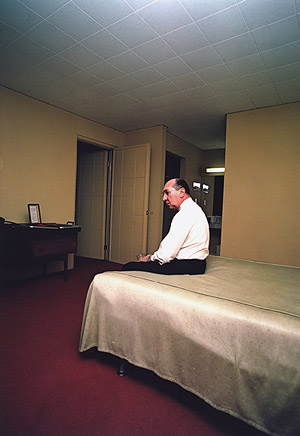
“Sometimes I’ll leave the house with a fully loaded camera and end up with nothing. Its just about being there. Anywhere. Even the most uninteresting, ugly or boring places can for an instant become magical to me”.
I really like this quote from Eggleston, he understands about there being a time and place. I feel my ambitions for my project may take of in the style of Eggelston, as he knows how to compose a story. Above, “Huntsville, Alabama, CA. 1970″ shows a strong image of a man with a high working class status of his time. His trimmed clothing and wide open spaces signifies his detailed identity of power and wealth. Eggleston’s work is very symbolic, an iconic representation of humans in a position of various power and status. I wish to base this aspect primarily around my own family, so the reader is able to understand a story without a composed narrative.

William Eggleston’s groundbreaking reinvention of color photography in the 1970s established him as one of America’s most original and influential artists. In Autumn of 2008, photographer Joanna Welborn made portraits of William Eggleston at the offices of his archive in Memphis, Tennessee. Welborn then spent time photographing throughout Memphis, at some of Eggleston’s favorite haunts as well as making photographs that evoke Eggleston’s own groundbreaking color images. Welborn here discovers a more intimate side to Eggleston, exploring the reminiscences of where he spends his time creating new ideas and media, the heart of his lifestyle and time. In my own project, I wish to accomplish a similar response so that the viewer could understand the relationship between my parents and our house.
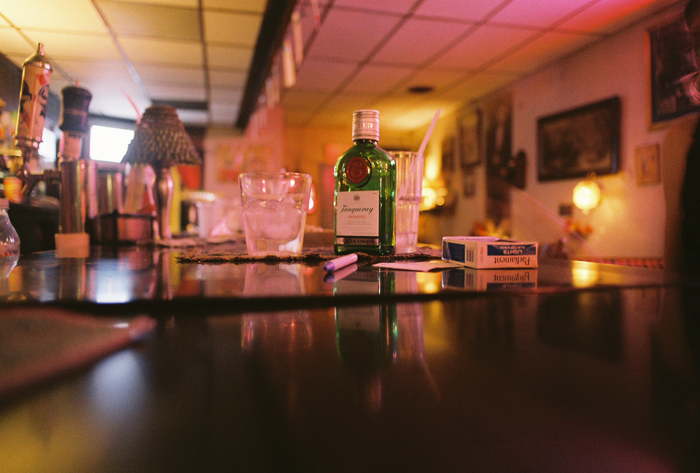
Here is a link to the Article about Joanna’s project on Eggleston: http://www.cdsporch.org/archives/2590
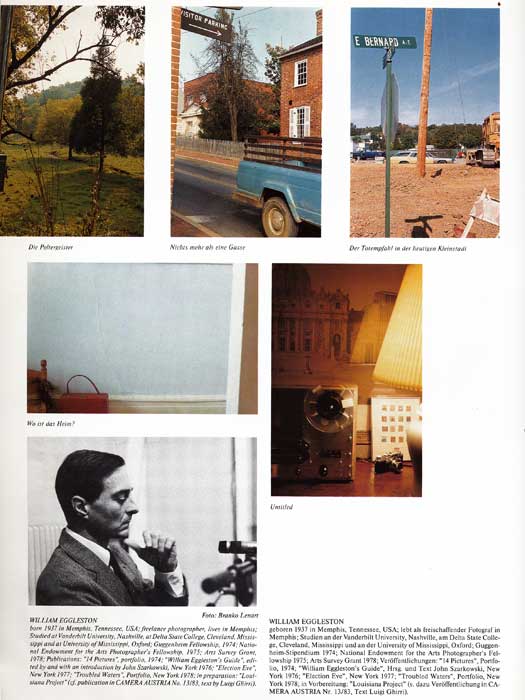
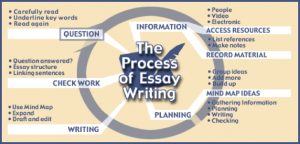
Week 18-19: 18th – 29th Jan
DEADLINE: Hand in draft version of your essay Fri 29th Jan.
Objective: Criteria from the Syllabus
Quotation and Harvard System of Referencing
ESSAY STRUCTURE
See below for a possible essay structure. Further help can be found here essay structure or see link here The Royal Literay Fund
Essay title: Hypothesis
Opening quote: Choose a quote from either one of your photographers or critics. It has to be something that relates to your investigation
Introduction (250-500 words).
Think about an opening that will draw your reader in e.g. you can use an opening quote that sets the scene. You should include in your introduction an outline of your intention of your study e.g. what and who are you going to investigate. How does this area/ work interest you? What are you trying to prove/challenge, argument/ counter-argument? Include 1 or 2 quotes for or against. What links are there with your previous studies? What have you explored so far in your Coursework or what are you going to photograph? How did or will your work develop. What camera skills, techniques or digital processes in Photoshop have or are you going to experiment with?
Paragraph 1 Structure (500 words) : Use subheading. This paragraph covers the first thing you said in your introduction that you would address. The first sentence introduces the main idea of the paragraph. Other sentences develop the subject of the paragraph.
Content: you could look at the following…exemplify your hypothesis and introduce your first photographer. Select key works, ideas or concepts and analyse in-depth using specific model of analysis (describe, interpret and evaluate) – refer to your hypothesis. Contextualise…what was going on in the world at the time; artistically, politically, socially, culturally. Other influences…artists, teachers, mentors etc. Personal situations or circumstances…describe key events in the artist’s life that may have influenced the work. Include examples of your own photographs, experiments or early responses and analyse, relate and link to the above. Set the scene for next paragraph.
Include relevant examples, illustrations, details, quotations, and references showing evidence of reading, knowledge and understanding of history, theory and context!
Paragraph 2 Structure (500 words) : Use subheading. In the first sentence or opening sentences, link the paragraph to the previous paragraph, then introduce the main idea of the new paragraph. Other sentences develop the paragraphs subject (use relevant examples, quotations, visuals to illustrate your analysis, thoughts etc)
Content: you could look at the following…Introduce key works, ideas or concepts from your second photographer and analyse in-depth – refer to your hypothesis…Use questions in Pg 1 or add…What information has been selected by the photographer and what do you find interesting in the photograph? What do we know about the photograph’s subject? Does the photograph have an emotional or physical impact? What did the photographer intend? How has the image been used? What are the links or connections to the photographer in Pg 1? Include examples of your own photographs and experiments as your work develop in response to the above and analyse, compare, contrast etc. Set the scene for next paragraph.
Include relevant examples, illustrations, details, quotations, and references showing evidence of reading, knowledge and understanding of history, theory and context!
Paragraph 3 Structure (500 words) : Use subheading. In the first sentence or opening sentences, link the paragraph to the previous paragraph, then introduce the main idea of the new paragraph. Other sentences develop the paragraphs subject (use relevant examples, quotations, visuals to illustrate your analysis, thoughts etc)
Content: you could look at the following…Introduce key works, ideas or concepts from your third photographer and analyse in-depth – refer to your hypothesis…Use questions in pg 1 and pg 2 or add…How does the photograph compare or contrast with others made by the same photographer, or to other images made in the same period or of the same genre by other artists. How does the photograph relate to visual representation in general, and in particularly to the history and theory of photography, arts and culture. What are the links or connections to the photographers in pg 1 and 2? What are the similarities, differences or links and connections? How does this work compare to yours? Include examples of your own photographs and experiments as your work develop in response to the above and analyse, compare, contrast etc. If more paragraphs are required, set the scene for the next paragraph.
Include relevant examples, illustrations, details, quotations, and references showing evidence of reading, knowledge and understanding of history, theory and context!
Conclusion (500 words) : Write a conclusion of your essay that also includes an evaluation of your final photographic responses and experiments.
List the key points from your investigation and analysis of the photographer(s) work – refer to your hypothesis. Can you prove or Disprove your theory – include final quote(s). Has anything been left unanswered? Do not make it a tribute! Do not introduce new material! Summarise what you have learned. How have you been influenced? Show how you have selected your final outcomes including an evaluation and how your work changed and developed alongside your investigation.
Bibliography: List all the sources that you used and only those that you have cited in your text. Where there are two or more works by one author in the same year distinguish them as 1988a, 1988b etc. Arrange literature in alphabetical order by author, or where no author is named, by the name of the museum or other organisation which produced the text. Apart from listing literature you must also list all other sources in alphabetical order e.g. websites, exhibitions, TV/ Videos / DVD/ Music etc.
DEADLINE: Hand in draft version of your essay Fri 29th Jan.
DON’T FORGET TO MAKE PHOTOGRAPHS & EXPLORE YORU IDEAS!!
We will begin work on editing and designing a photobook next week. If you don’t have any content i.e. text and images you can’t make a photo book!